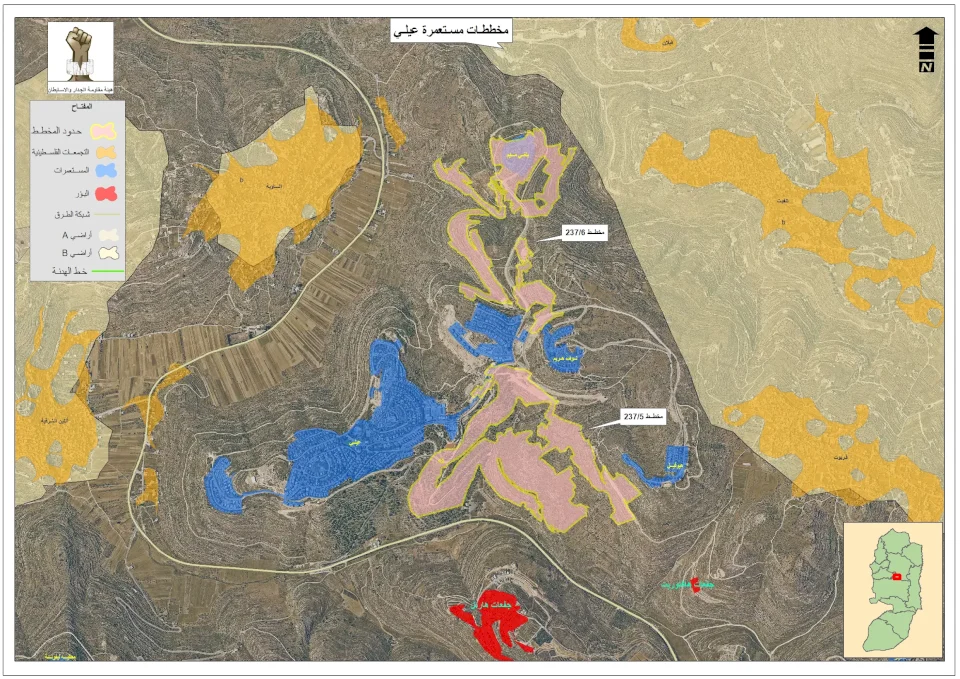
Resistance to the Wall and Settlement: The Occupation Authorities Transform Two Colonial Outposts into New Neighborhoods
SadaNews - The Wall and Settlement Resistance Authority revealed a systematic transformation of a group of large colonial outposts around the settlement of Eli, established on the lands of citizens in the villages of Sawiya, Lubban, and Qaryut, into large neighborhoods affiliated with the settlement. The head of the authority, Minister Moayed Shaban, stated that the state of occupation had approved a series of large structural plans aimed at massive expansion of the Eli settlement in order to complete plans to separate central West Bank from northern West Bank through the extensive colonial cluster between the settlements of Shilo and Eli and the surrounding outposts in the gap between the Ramallah and Nablus governorates.
Shaban noted that the state of occupation submitted a structural plan in July that pertains to the settlement, numbered יוש/ 7/ 237, which aims to construct 50 new colonial units on an area of 8.6 dunams. The plan is positioned on fragmented parcels of land on which the settlement is situated. Recently, the authorities approved two large plans; the first is numbered יוש/ 5/ 237 over an estimated area of 638 dunams aimed at building 650 new colonial units to regularize the status of a large colonial outpost east of Eli. They also approved plan numbered יוש/ 6/ 237, which aims to build a total of 347 new colonial units on an area of 383 dunams to regularize the status of the Hiville Harim outpost and convert it into a neighborhood that falls under the settlement and enjoys all the privileges afforded by the occupation government to the colonial project that annexes Palestinian lands.
The planning authorities in the state of occupation studied 39 structural plans in July for the benefit of West Bank settlements and included within the municipal boundaries of the occupation in Jerusalem, consisting of 34 plans for settlements in the West Bank and 5 plans for settlements within the municipal boundaries of the occupation in Jerusalem. He pointed out that these authorities approved 22 structural plans for West Bank settlements and submitted 12 plans leading to the approval for the construction of 4,492 new colonial units, and the submission of 1,095 new colonial units on an area estimated at 5,268 dunams. Meanwhile, the Jerusalem municipality approved one plan and submitted four plans for subsequent approval pertaining to settlements within the municipal boundaries of the occupation in Jerusalem, which included 260 colonial units that were submitted but not approved, covering an area estimated at 46 dunams of citizens' lands.
Shaban emphasized that the state of occupation continues to impose facts on the Palestinian geography that would lead to the fragmentation of Palestinian land and enforce a system of enclaves to eliminate the possibility of establishing a Palestinian state in the future. He asserted that what the state of occupation is doing on the ground constitutes grave violations of the simplest human rights norms that do not only infringe upon the capabilities of the Palestinian people and their inalienable rights, but also intensifies its assault on the resolutions of the international community, UN resolutions, and the declared legal positions in this regard.

Palestinian Bar Association: Israeli Death Penalty Bill is a Step Towards Legalizing Crime...

The Supreme Judiciary and Public Prosecution Launch Guidelines and Code of Conduct for Juv...

Local Governance: Municipal Councils Will Transition to Managing Affairs Starting December...

Injury of Two Young Men in a Traffic Accident in Jerusalem

Japan Supports the Expansion Project of Rafat Secondary School for Boys

Occupation Arrests 4 Citizens Including Two Women from Nablus City

Settlers Plow Citizens' Lands East of Idna Town

